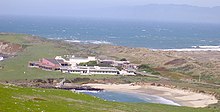This article includes a list of general references, but it lacks sufficient corresponding inline citations. (May 2017) |

The University of California Natural Reserve System (UCNRS) is a system of protected areas throughout California.[1] The reserves support UC's mission of teaching, research, and public service. Unlike national and state parks, they are not available for recreational uses, because they were specifically created to enable UC scientists to conduct research free from such distractions.
The system began with UC Berkeley zoology professor Joseph Grinnell. In 1937, near the end of his career, Grinnell began to work on a proposal to establish UC's first wildland field station for zoology teaching and research. He had initially looked to the U.S. national parks for research sites, but became frustrated with the National Park Service and how its other priorities often got in the way of his priorities. Grinnell became convinced that only a natural reserve owned by the university itself "would provide the permanent protection necessary for long-term teaching, research, and monitoring of California's ecosystems."[2]
Grinnell did not live long enough to see his proposal succeed. In May 1939, two weeks after Grinnell's sudden death from a heart attack, the Regents of the University of California voted to accept his proposal and created the oldest reserve in the system, Hastings Natural History Reservation.[2]
On January 22, 1965, at the suggestion of Kenneth S. Norris, the UC Board of Regents voted to formally join together Hastings and six other reserves into the Natural Land and Water Reserves System.[3] In 1970, it was renamed to the Natural Reserve System.
- ^ "University of California Natural Reserve System—UCNRS". The Regents of the University of California. Retrieved 8 April 2013.
- ^ a b Alagona, Peter S. (2013). "Evolution of the UC Natural Reserves: An Introduction". In Fiedler, Peggy L.; Rumsey, Susan Gee; Wong, Kathleen M. (eds.). The Environmental Legacy of the UC Natural Reserve System. Berkeley: University of California Press. pp. 9–29. ISBN 9780520272002. Retrieved March 24, 2023. (at p. 10.)
- ^ Alagona, Peter S. (2013). "Evolution of the UC Natural Reserves: An Introduction". In Fiedler, Peggy L.; Rumsey, Susan Gee; Wong, Kathleen M. (eds.). The Environmental Legacy of the UC Natural Reserve System. Berkeley: University of California Press. pp. 9–29. ISBN 9780520272002. Retrieved March 24, 2023. (at p. 12.)
